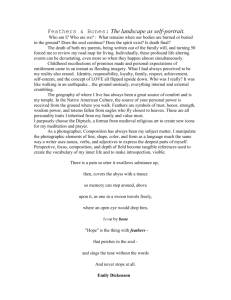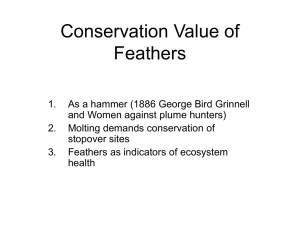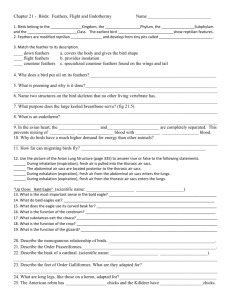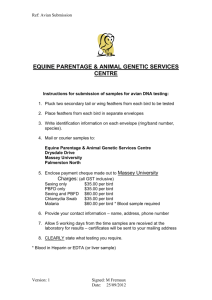Feathers & Feather Tracts
advertisement
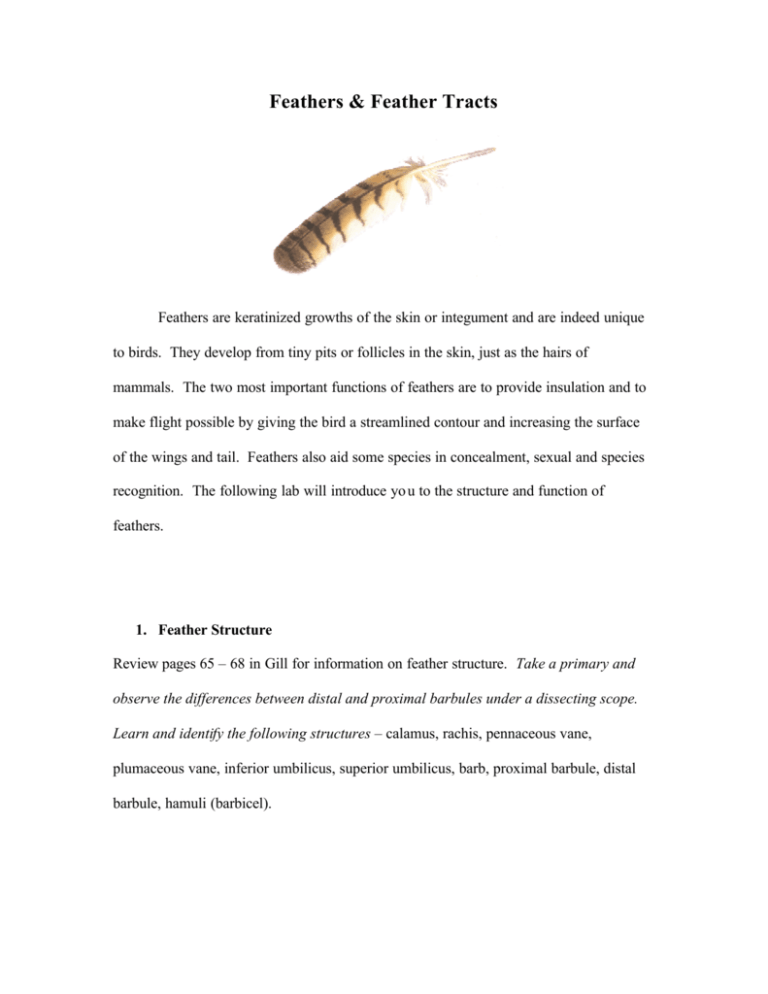
Feathers & Feather Tracts Feathers are keratinized growths of the skin or integument and are indeed unique to birds. They develop from tiny pits or follicles in the skin, just as the hairs of mammals. The two most important functions of feathers are to provide insulation and to make flight possible by giving the bird a streamlined contour and increasing the surface of the wings and tail. Feathers also aid some species in concealment, sexual and species recognition. The following lab will introduce yo u to the structure and function of feathers. 1. Feather Structure Review pages 65 – 68 in Gill for information on feather structure. Take a primary and observe the differences between distal and proximal barbules under a dissecting scope. Learn and identify the following structures – calamus, rachis, pennaceous vane, plumaceous vane, inferior umbilicus, superior umbilicus, barb, proximal barbule, distal barbule, hamuli (barbicel). 2. Feather Colors Birds are among the most colorful of all vertebrates. The colors seen in bird plumages are produced by a variety of pigments and structural adaptations of the feather. There are three principal pigments found in bird feathers. a. Melanin – The most common pigments in feathers. Melanin is synthesized by the bird through oxidation of the amino acid tyrosine. The melanin granules produce color in direct proportion to their presence; the more melanin the darker the color. Melanin occurs in all types of feathers but is often associated with the flight feathers. Colors resulting from melanin include; black, gray, dark brown, light brown, brick red, dull yellow, and tan. b. Carotenoids – This pigment is derived exclusively from the birds diet. Once eaten, the color and chemical structure of the carotenoid pigments may be modified in the bird’s body. Carotenoids are fat-soluble pigments and appear in a diffuse state rather than in the form of granules. Most of the bright reds, oranges, and yellow colors seen in birds are carotenoid pigments. c. Porphyrins – These are feather pigments related to hemoglobin and other bile pigments formed by the breakdown of hemoglobin by the liver. Porphyrins occur in many groups of birds, including rock doves, owls and gallinaceous birds. The most common porphyrins produce brown pigments but can also produce bright red and greens as seen in Turacos and a few other species. Structural colors result from the modification or separation of the components of white light by the structure of the feather. In white feathers the feather structure simply reflects back the whole spectrum. Blues and greens result when light is scattered through the fine layers of cell walls in the barbs. Combinations of structural and pigment colors are common, particularly in yellow-green, green, and blue-green feathers. Iridescence is caused by the complex layering of cell walls and melanin granules in the barbules of the feathers. These structures selectively absorb or reflect varying wavelengths of light. The exact colors seen depend on the viewpoint of the observer. Observe the various feather colors on display and note whether the color is due to a pigment or a structural feature. Place under a compound microscope small feathers or portions of feathers, mounted on slides. Study the colors, using first reflected light (light falling on the feather from the side or above and then reflected back to your eye) and then transmitted light (light passing through the feather to reach your eye). 3. Feather Types There are six major types of feathers which together provide a wide range of functions. Observe examples of each of the following types of feathers. a. Contour feathers – Note both the smaller vaned feathers on the body and the larger flight feathers of the wing and tail. Some species (e.g. gallinaceous birds) have prominent aftershafts. b. Semiplumes and down feathers – Note the soft plumaceous barbs which lack the barbicels that keep the contour feathers together. View both contour and a semiplume or down feather under a microscope (100x) and note the great difference in the structure of the barbs in the two types of feathers. c. Bristles – View the rictal bristles around the mouth of the Common Poorwill. These feathers may be used as tactile structures. d. Filoplumes – These whiskery feathers are scattered throughout the plumage. They help the bird determine the location of its main flight feathers, provide it with a sense of touch within the plumage, and may even help the bird judge its airspeed when flying. e. Powder feathers – A specialized feather, some times called powder down. The barbs of this feather disintegrate into a fine powder as the feather matures. Powder feathers are thought to aid the bird in grooming its plumage although the exact role is not understood. Patches of powder down shed water, which has led to the speculation that they have a waterproofing function. Highly developed yellow powder feather patches are best viewed under the breast plumage of a heron or a bittern. These feathers are present in most species but are widely scattered so they are difficult to isolate. Using a frozen Rock Dove, locate and remove examples of contour feathers, semiplumes, down, and filoplumes. Examine each under the microscope. 4. Feather Tracts In most modern birds the contour feathers of the wing and body are not uniformly distributed over the skin surface. The pattern of distribution is called pterylosis. The follicles of the contour feathers are concentrated in dense tracts called pterylae and are separated by bare areas called apteria. In some groups of birds, (e.g. Sphenisciformes) contour feathers are evenly distributed over the body. Pterylosis is best observed in a fresh specimen. Begin by parting the feathers of the breast, abdomen, back and shoulders to note the general location of the apteria and the major feather tracts. Next use a pair of scissors to remove the contour feathers of the entire thorax, abdomen, back and one of the wings. Clip feathers close to the body to reveal pterylosis. Carefully clip or pluck the contour feathers of the wings from around the bases of the primaries and secondaries. Use the diagram on the following page to locate the major feather tracts of the Rock Pigeon. Learn the major feather tracts on the preserved nestlings provided. 5. Plumage Patterns The evolutionary development of color in birds has resulted in two contrary but equally adaptive general types. The first type reduces the conspicuousness of the bird and enhances concealment whereas the second type advertises or facilitates the bird’s recognition. Observe examples of the following plumage patterns. a. Cryptic coloration – Cryptic coloration is almost exclusively related to protection against predators. For example many of the ground-dwelling Galliformes have an inconspicuous brown or tan color, whereas birds of the treetops like vireos or warblers often resemble the green sun flecked foliage. b. Countershading – This refers to the development of dark colors on the back of the bird and lighter colors on the abdomen. The net effect of the contrasting gradients in color is to reduce the three-dimensional roundness of the animal (as ordinarily indicated by shadows) and convert it to an inconspicuous, flat, even-toned object. c. Disruptive coloration – This consists of bold contrasting patterns such as rings on the head, neck or back, which optically break up the body into two pieces (creating a hiatus between the head and body). Disruption of the visible form of the bird helps prevent its recognition as a bird by potential predators. d. Recognition marks – Marks used by birds to signal some intent or danger. The white outer tail feathers of the Junco may serve as a signal to keep the flock together and the malar stripe of the Flicker serves as a means of sexual recognition. e. Phanerogamic coloration – Coloration used by birds in courtship displays to attract mates. If colorful feathers are absent many birds have other structures such as combs, wattles and even feet that are colored.
